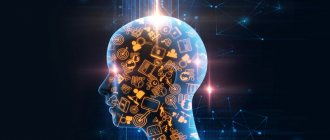One of the most interesting and mysterious areas of our psyche is the world of emotions. Studied for thousands of years by scientists from various fields of knowledge, it still keeps many of its secrets and mysteries. Emotions permeate our entire life, making it bright, rich, sometimes tremulous and tender, sometimes filled with unbearable burning pain. Yes, they are this life itself, because where feelings disappear, human existence ends.
It is psychology that most fully reveals the essence of this area of the human psyche - the only science that has managed to organically link together the physiological basis and manifestations of emotional states.
Basic functions of emotions
Reflective-evaluative function. The significance of objects and situations that are necessary to achieve goals and satisfy human needs is assessed using emotions. Emotions are a system of signals that makes it possible to understand the significance of events.
Incentive function. By assessing what is happening, a person motivates himself to take some action. S.L. Rubinstein argued that emotion contains attraction, desire, desire, directed towards an object or away from it.
The activating function has a close connection with the incentive function. Emotions provide the necessary level of activity of the human central nervous system. The dynamics, tempo, and rhythm of activity are influenced by various emotional states. Positive emotions, such as joy and confidence, add dynamics to activity processes and encourage a person to take active, intense actions. Scientist D. Hebb has proven the dependence of the effectiveness of human activity on the level of his emotional state. Hebb calls this dependence curvilinear, “bell-shaped.” To achieve high performance results, you need to have an optimal level of emotional arousal. Too weak and very strong emotional states are undesirable. The optimal level ensures maximum efficiency in the process of activity. It depends on the conditions of the activity performed, the individual properties of the person involved in the activity.
Note 1
If emotions are weak, then the person has insufficient motivation. If emotions are too strong, a person becomes disorganized and uncontrollable, which destroys activity.
Regulatory function. Emotions regulate and direct human activity, limiting or, on the contrary, expanding it. When an emotional attitude towards an object arises, it affects the motivation of activity at all its stages. With the help of emotions, a subjective assessment of what is happening is given. This means that the same event can be emotionally perceived differently.
Synthesizing function. Individual events and facts are built into one whole with the help of emotions. Scientist A.R. Luria proved that many images that are directly or indirectly associated with an object that gave rise to a strong emotional experience are combined into a stable complex in the human mind. If one element is actualized, other components of this complex are reproduced in consciousness, sometimes even against the person’s desire.
Meaning-forming function. Human actions gain meaning through emotions. A.N. Leontyev argued that successful actions performed during the day may not satisfy a person and even spoil his mood. The negative aftertaste will be barely noticeable against the background of worries throughout the day. But when a person begins to mentally analyze the day he has lived, a certain event appears in his memory. The mood acquires an objective correlation, a signal appears indicating an event that left unpleasant sensations. This could be a negative reaction to someone else doing something more successful. The man thought and acted correctly, as it seemed to him, and this was the main motive of his activity, but in reality it did not turn out quite like that.
Protective function. Strong emotional experiences, such as fear, send a signal to a person that there is danger and encourage him to think carefully about his actions. That is, fear is a person’s protection from unpleasant consequences.
Expressive function. All emotions contain an expressive component. Through it, a person establishes relationships with other people.
The question of the functions of emotions has been developed by many scientists; there are several classifications, including Simonov, Leontiev, Wundt.
The importance of emotions is enormous in human life. Scientists, psychologists, have found it necessary to clearly differentiate them. The German philosopher I. Kant identified two types of emotional states according to the degree of activation: sthenic and asthenic emotions.
Thenic emotions cause an increase in human activity, while asthenic ones, on the contrary, reduce it. Emotions can be positive and negative, intense, long-lasting, conscious and unconscious.
Note 2
Human emotions can be distinguished by modality and quality of experience.
Psychologist K. Izard identifies ten main emotions, three of them are positive, seven are negative.
How to use it
It must be remembered that emotion does not exist “by itself” - it is the result of an assessment of a certain situation. And, first of all, it is advisable to realize what kind of situation the emotion relates to. And defining the situation already provides an excellent opportunity for control - we understand how we evaluate it. And, if the assessment does not suit us, it may reassess the situation. A
the characteristics of an emotion will help us determine what exactly needs to be changed in the perception of the situation.
Why you can use any NLP tools:
- add resources to the situation using anchors ;
- make a submodal shift ;
- dissociate from the situation;
- transfer a situation from the present to the past;
- do reframing ;
- reassess the criteria of the situation;
- scale the main characteristics : sign, importance, and this can be done both for assessment and for emotion;
- use any other NLP techniques.
What are emotional states
In psychology, the concept of “emotions” is used both in a broad sense, as emotional states, and in a narrow sense, as one of the types of these states, along with feelings, moods, affects, etc. Emotional states are a special class of mental phenomena that reflect attitudes man to the world.
Emotions and needs
Interacting with the world around us and with other people, a person constantly encounters situations that evoke different attitudes in him: joy or indignation, sadness or hatred, surprise or sympathy. That is, a person reflects the world and stores information in memory not only in images and concepts, but also in the form of sensory experiences - emotions.
Emotions are closely related to human needs. Those life circumstances, situations or people that contribute to the satisfaction of needs cause us positive emotions, and those that interfere or hinder us cause negative emotions. It's so simple and complicated at the same time.
- Firstly, we are not always aware of our needs, but we always experience the emotions associated with them. Therefore, we often cannot even explain to ourselves why we don’t like this or that person, or why our mood suddenly deteriorated.
- Secondly, a person lives a complex and multifaceted life, and often his needs come into conflict not only with the needs of other people, but also with his own desires. Therefore, understanding this confusing and chaotic whirlpool of emotions can be extremely difficult even for an experienced psychologist. You probably know that you can love and hate the same person at the same time, or be afraid and look forward to some event at the same time.
You can deal with your experiences only by realizing and bringing your confused desires and needs into at least relative order. Experienced psychotherapists can help a person with this. After all, only by understanding and accepting your needs or consciously abandoning them can you reduce the severity of negative experiences.
Psychophysiology of emotional states
Emotions are the oldest type of mental states; animals have them and are associated with the satisfaction of natural, and in higher animals, social needs.
- The antiquity of this type of mental state is confirmed by the fact that they are born in the old, from an evolutionary point of view, subcortical part of the brain - in the limbic system. By the way, the name is very telling. Limbo is purgatory, a place between heaven and hell, and even deeper lurks animal instincts and hidden, often dark desires and needs. They sometimes break through from the subconscious level, awakening in us strange emotions that frighten even ourselves.
- But the expression of emotions is controlled and controlled by the “youngest” and most rational part of the brain – the neocortex (“new cortex”). And when the rational part of the brain turns off, for example, during severe alcohol intoxication or in a state of passion, then emotions go out of our control, and behavior begins to be controlled by instincts, not reason.
Any external influence causes a focus of excitation in the cerebral cortex. If the irritation is weak, then the focus quickly fades, but the stronger the impact, the larger and more stable this focus is. Penetrating into the subcortical zone, it activates the centers of emotions.
Emotions, in turn, cause various changes in the physiological systems of the body, because emotions are a signal about the nature of the impact of the stimulus. And if they are negative, then our body is rebuilt, preparing to repel danger or run away from it. Moreover, for our brain, it turns out, it doesn’t matter whether the enemy is real or imaginary - the signal to restructure the body’s functioning is still received, and we experience various, often unpleasant, sensations. Thus, the emergence of a feeling of fear is accompanied by the following processes:
- Adrenaline is released into the blood, which should increase the supply of oxygen to the muscles and activate the sympathetic nervous system;
- blood and nutritional resources are directed to support the muscular system; this reduces the supply to other body systems, so a person feels cold, chills, his face turns pale, and due to lack of blood supply, dizziness and even loss of consciousness may occur;
- in order to cope with the increased needs for blood supply, the heart begins to beat faster, breathing quickens to supply the blood with oxygen and, as a result, difficulties arise with speech;
- rational control over behavior decreases, since the functions of the cerebral cortex are somewhat suppressed, and the person literally becomes stupid and does not think rationally well.
Changes in the functioning of various body systems under the influence of emotions are reflexive in nature, so we cannot consciously control them, but we can control emotions, at least at the initial stage of their occurrence. Our brain is quite capable of “persuading” the body not to succumb to feelings of fear or anger. And in psychotherapy there are special techniques and trainings that allow a person to learn to manage their emotions even in the most critical situations.
Managing emotions is necessary not only to regulate behavior, but also to maintain physical health. The fact is that negative feelings (and they are experienced more strongly by a person than positive ones) have very unpleasant consequences. Their systematic experience can lead to the development of psychosomatic diseases, primarily of the cardiovascular and digestive systems. It is these systems that are most affected by adrenaline surges and other physiological changes. That is, the saying: “All diseases come from nerves” has a rational basis.
Fundamental human emotions
Interest-excitement. An emotion that a person experiences more often than others. The importance of this emotion for motivation in developing skills and acquiring knowledge should be emphasized. Interest opens the way to curiosity, exploration, and expansion of experience. If the interest is intense, the person is in a state of inspiration and revitalization.
Joy can be characterized by feelings of confidence, significance, enjoyment and satisfaction. A person is satisfied with himself and the world around him, he feels strength and energy. Joy is a feeling that arises when achieving something, realizing one’s abilities, satisfying one’s desires.
Astonishment. The peculiarity of this emotion is that it arises quickly and passes just as quickly. This is a transitory emotion. Surprise cannot be a motive for behavior over a long period. The function of this state is to prepare a person for subsequent actions, for new events.
Suffering. One of the most common negative emotions. It is dominant in grief and depression. There are many reasons for suffering. These are problems of everyday life, states of need. When describing suffering, they note loss of spirit, loneliness, isolation, despondency. The emotion signals to the person and his environment that he is feeling bad. Emotion prompts a person to take actions that alleviate this condition and eliminate the cause of suffering. The most severe form of suffering is grief. The source of grief is loss. The state of grief is very difficult for a person to experience.
Anger. A very strong negative emotion. Anger arises as a result of non-realization, failure to achieve what is passionately desired. The causes of anger can be: personal insult, deception, coercion. When a person experiences anger, he feels his strength and feels the desire to crush the source of anger. The greater the intensity of the anger, the stronger the subject and the greater his desire to physically act. Rage is the highest manifestation of this emotion. Here the mobilization of energy is so great that a person is forced to throw out this energy. This manifests itself in various ways.
Disgust. This emotion occurs when a person seeks to eliminate or change an object. In the human mind there is a mismatch between the value-significant and the ugly-imperfect. Disgust can be caused by objects, actions, and actions. Like anger, this emotion can be directed at oneself, then self-esteem decreases and a feeling of self-condemnation arises.
Contempt. If a person experiences this emotion, then he should feel smarter, stronger, more confident than the despised person. The person experiences a sense of superiority and devalues the qualities of others. It's a hostile feeling. A person is hostile to someone he despises.
Fear. A strong and dangerous emotion. The cause of fear can be an event, a condition that signals danger. This emotion controls a person’s consciousness and behavior. He can experience a state of fear as a premonition of trouble, uncertainty, insecurity, a threat to his existence. There are many types of fear: from unpleasant foreboding to horror.
Shame. When experiencing a feeling of shame, a person seems to be small, constrained, upset, and worthless. Emotion paralyzes mental activity, a person is deprived of the opportunity to think logically for some time. Shame can cause feelings of self-loathing.
Guilt. An emotional state resulting from wrong actions. A person feels guilty when he realizes that he has violated the rules, that he has crossed the boundaries of something. Guilt can arise in connection with condemnation of one's action. Reactions to feelings of guilt include remorse, self-condemnation, and lowered self-esteem. When a person is personally responsible for something, a feeling of guilt arises. This emotion is long-lasting and painful.
Cognitive content
According to this classification, feelings are divided into simple and complex. The first ones are fast and bright (anger, joy). They occur momentarily, immediately upon encountering a factor that motivates them (for example, when a guy invites a girl on a date, she rejoices). The second ones are longer and often contradictory (after receiving an invitation, she begins to analyze the situation and doubt).
What are the different emotions?
Positive and negative basic human emotions make up a relatively small list of ten manifestations:
- Joy;
- Sadness;
- Disgust;
- Astonishment;
- Anger;
- Guilt;
- Fear;
- Interest;
- Shame;
- Contempt.
The classification of emotions involves the emotions themselves and the feelings themselves. In addition, it is customary to distinguish additional mental states: passion, affect, stress, mood. All human emotions make up a much larger list. It includes different aspects of fear, pleasure, anger. We can say that in the human community, with the development of the mental sphere, gradations of basic emotions appeared, which began to be called feelings.
What are the emotions a person has, list:
- Excitement;
- Despair;
- Fury;
- Safety;
- Anxiety;
- Gratitude;
- Sorrow;
- Satisfaction;
- Disgust;
- Astonishment;
- Anger;
- Guilt;
- Dejection;
- Delight;
- Anxiety;
- Arrogance;
- Shame;
- Pride;
- Fear;
- Sadness;
- Calm;
- A pity;
- Confusion;
- Gloat;
- Compassion;
- Interest;
- Boredom;
- Irritation;
- Hope;
- Disappointment;
- Tenderness;
- Lust;
- Hatred;
- Contempt;
- Dislike;
- Joy;
- Sadness;
- Sadness;
- Disgust;
- Resentment;
- Disgust.
Some of them are close to each other in sensations and manifestations, related mental states. But due to emotional development, a person is able to separate fear and caution, tenderness and lust. Some researchers include in the list such manifestations as: hunger, thirst, fatigue. These concepts are not emotions, they appear as a result of signals to the brain that are sent by the body's receptors. But the anger, indignation and resentment that arise as a result of these sensations can already be safely called emotions.
Positive emotions
We ourselves put a plus or minus sign in front of any emotion. This is actually a very subjective assessment. Any emotion is a physiological response to a stimulus (internal or external). To be precise, this applies to those manifestations due to which the so-called “pleasure hormone” is produced.
Therefore, the list of positive human emotions given below is also conditional:
- Joy;
- Love;
- Interest;
- Satisfaction;
- Calm;
- Tenderness;
- Surprise (questionable);
- Lust.
Characteristics of positive emotions: what is commonly called positive causes pleasure. If the cause is external, then a person strives for it again and again. If it is inside, then an instinctive desire arises to resume the state that causes the release of endorphins. This is how attachments of dependence on something or someone that causes pleasure arise (objects of art, pets, a loved one).
Even positive emotions have a dark side. A maniac and murderer, rapist, torturer of his victims takes pleasure in his perverted activities. The use of narcotic drugs, alcohol, and psychotropic drugs causes artificial bursts of joy and pleasure, becoming the cause of addiction, which is extremely difficult to overcome.
Even fish can show positive emotions. When they see a potential partner, they show their interest by showing it through their behavior. “Body language” is used by all living beings, although the range of emotions and their depth differ depending on what stage of evolution they are at. At the moment, humans are considered the most developed mammal, although recently they are increasingly saying that dolphins may supplant us on this pedestal.
Strong emotions provoke the release of adrenaline into the blood, regardless of whether they are positive or negative. If there is too much shock (feeling of danger), there is so much of it that the body is not able to cope with the huge dose, the psyche is in a state of stress, and the body is ready for active action, while consciousness may be clouded.
In this case, it is customary to talk about a state of affect. Positive emotions help produce oxytocin (pleasure hormone), dopamine and endorphin (happiness hormones). If something frightening and joyful happens at the same time (for example, childbirth), then the blood turns into a “chemical cocktail” oversaturated with various hormones.
Each of them plays a role in maintaining the vitality of the body. This is how the evolutionary mechanism inherent in us by nature works.
To obtain positive emotions, you can use the properties of the physical body. For this you can use:
- Moderate physical activity. A walk in nature, around the city. Not too tiring work, jogging, dancing - all these actions contribute to the production of endorphins. Especially if all this happens in the fresh air in a beautiful place that can bring aesthetic pleasure.
- Favorite hobby. Doing something enjoyable also helps lift your mood.
- Watching a movie or reading a book. A good work of art deeply touches our feelings, and can even cause catharsis - emotional release through deep emotions, tears. This is a good “reboot” for the body.
- Communication with pets. Cats, dogs, and other animals can relieve stress, help you relax and bring a lot of positive emotions with their behavior and even their simple presence.
- Doing good deeds. We are not talking about something global. Small pleasant things that bring pleasure to others resonate in the same way within ourselves. Seeing joy on the face of another person, we receive a non-verbal signal and, against our will, mirror a good mood.
That's why they talk about "infectious laughter", "infectious positivity" and an involuntary improvement in mood in the presence of someone experiencing joy. Joy can be shared, but grief can be infected precisely for this reason - we perceive signals on a subconscious level and project them onto ourselves. Even a drawing (a smiley face) that conveys a mood has a subtle impact.
Negative emotions
The list of a person’s negative emotions is also conditional. “Bad” feelings should be treated as a defense mechanism that has been developed over thousands of years. That is why there is no need to reproach yourself for fear or be ashamed of feeling anxious. However, it is worth remembering that negative emotions encourage certain actions, bad deeds. This is what you need to work with.
If you experience a flash of anger, it is natural and will pass over time, but fighting, insulting, or even more severe actions under the influence of this emotion are something that you need to be able to control.
Destructive emotions have a destructive effect on the psyche and nervous system. These include:
- Sadness;
- Sadness;
- Dejection;
- Stress;
- Fury;
- Anger;
- Fear;
- Depression.
All these manifestations can significantly worsen health if a person experiences them for a long time. This is explained simply by the same chemical reactions.
The body responds by releasing certain substances into the blood that increase blood pressure, increase alertness, and give strength. But they all work only with short-term exposure. Prolonged and prolonged entry into the blood causes a condition close to poisoning. Active substances break down, releasing toxins. If there are too many of them, then the body simply cannot cope and receives the command to “die”. Therefore, negative and destructive emotions are more dangerous than they might seem. These are not just thoughts in the head, it is a process in which the whole body is involved.
The list of emotions that are commonly called negative:
- Fear;
- Resentment;
- Aggression;
- Anger;
- Gloat;
- Jealousy;
- Dejection;
- Sorrow;
- Yearning;
- Disgust;
- Confusion.
This list can be supplemented, since in human language there are many names for feelings and experiences that can also be called emotions. I left only the main ones, those that, in my opinion, have the most ancient origin and are closely related to physiology.
Human Emotions Chart
| Positive emotions | Negative emotions |
| Joy | Fear |
| Love | Resentment |
| Interest | Aggression |
| Satisfaction | Anger |
| Calm | Gloat |
| Tenderness | Jealousy |
| Astonishment | Dejection |
| Lust | Sorrow |
| Yearning | |
| Disgust | |
| Confusion |
Mood
Mood is a prolonged emotional state of average intensity, a certain emotional background for mental processes. This is also a state that characterizes a certain object, its mood (picture, melody).
Affect and stress
Affect is an emotional state of an explosive nature, short-term, intense, with a pronounced change in motor processes and the functioning of internal organs. It is an unconscious assessment of a given situation. It is characterized as severe emotional disturbance.
In a moment of passion, a person may say too much
Block 2. Emotions in psychology. The structure of experiences.
Now we will look at the components of emotional experiences using the example of a secretary.
2.1. Subjective emotional experience.
A secretary pours mineral water for the heads of two companies before upcoming negotiations. And at this moment, perhaps she is worried. She is not in the best mood. The secretary experiences anxiety when making autobiographical memories. Perhaps she is experiencing a conflict with a colleague the day before and therefore is in the context of “ there and then ” instead of being “ here and now ”. This state is a light trance.
2.2. The total reaction of the body.
Due to the memories, the secretary's heart rate increases and slight holds in her breath occur. She is in a state of slight stress. This is accompanied by increased tone of the muscles of the shoulder girdle. As a result, the secretary’s hand “trembled”, and the water ended up not inside the glass, but on the conference table, where the documents were laid out.
2.3. The internal monologue that accompanies an emotion.
The secretary instantly changes her internal monologue. She says to herself something like this: “What a bungler I am, what will happen now, how awkward it is in front of the guest and her boss.”
2.4. Motor reactions on the face and body.
You can observe sensorimotor reactions in the secretary, her eyebrows rise up, her lips “curve,” she turns pale, her pupils constrict. Overall muscle tone has increased. There is an immediate bodily reaction to stress.
2.5. Generalized emotional reaction.
The secretary experiences a cocktail of mixed experiences: shame, fear, anger at herself.
2.6. Cliched actions that accompany this emotional reaction.
The secretary begins to apologize in a “depressed” voice and tries to smooth out the situation. He looks for napkins and tries to dry the puddle of water on the table.
All these components appear almost simultaneously. Each of them is not independent, and they influence each other. When experiencing a strong emotion, processes of compliance with this experience are launched in the human body. The body becomes ready for activity. Then the emotion fades and the person’s body returns to its normal state.
All mental processes are covered by the “isolation” of emotional experiences.
How are feelings different from emotions?
Close in meaning, but still not identical, are the concepts of emotions and feelings. In scientific psychology, these terms define different components of a single emotional background.
Feelings are deeper states that determine a person’s stable attitude to surrounding events. They are often less pronounced and have smoothed manifestations. Emotions are a reaction-outburst to a specific situation, causing vivid manifestations, often born unconsciously. In psychology, feelings are more conscious manifestations of attitudes towards a particular object. A person can experience the whole gamut of emotions, but at the same time not show feelings if there are no prerequisites for this. For example, do not hate an enemy if the enemy does not exist. At the same time, show anger if something served as a reason for this.
The feelings inherent in a particular person are significantly influenced by the society surrounding the space. Emotions are a subjective assessment based on an internal understanding of reality and the characteristics of the nervous system.
Types of feelings
In fact, this part of the perception of the environment is difficult to classify, since it is multifaceted and diverse. Conventionally, psychology defines the following types of feelings:
- moral;
- intellectual;
- practical;
- aesthetic.
| Category | Subcategory | Manifestations | Characteristic |
| Moral | Moral | Humanity | Relationships between people, attitudes towards one’s own position in society, determination of acceptable behavior, the limits of what is permitted. |
| Patriotism | |||
| Call of Duty | |||
| Love | |||
| Immoral | Cruelty | ||
| Selfishness | |||
| Hatred | |||
| Greed | |||
| Intelligent | Specific | Inspiration | Determine attitude to intellectual needs. |
| Determination | |||
| Thirst for knowledge | |||
| Satisfaction from new knowledge and discoveries | |||
| Nonspecific | Curiosity | ||
| Astonishment | |||
| Humor | |||
| Irony | |||
| Praxic | Choice of activity | Profession | They determine the attitude towards everyday worries, responsibilities, and relationships with society. |
| Favorite leisure activity | |||
| Interesting activities | |||
| Aesthetic | Satisfaction from seeing, touching, listening | Love for nature | Determine the range of interests aimed at satisfying aesthetic needs |
| Love for technology | |||
| Favorite music | |||
| Works of art, architecture, sculpture |
There are more complex feelings that cannot be clearly attributed to one of the types. For example, love awakens a person to strive for knowledge, to reveal aesthetic potential, inspires, and determines the choice of activity.
Managing Emotions
Management is needed in order to overcome barriers to communication and mutual understanding. Many people believe that uncontrollable emotions need to be suppressed, although this is not the answer. A psychologist will help in their management. The support of friends and loved ones is important.
One individual experiences different feelings towards a certain object, sometimes contradictory. Another person is suffering from uncontrollable emotions and needs help. Emotionality occupies an important place in psychology due to the fact that people differ in this quality from other living beings.
What are feelings for?
The functions of feelings in psychology are determined by their ability to leave information about significant events and objects.
- reflective - an assessment of what is happening in order to determine the degree of danger in order to find ways to prevent it;
- stimulating - feelings encourage you to look for ways to solve certain problems and determine goals for the future;
- reinforcing - thanks to feelings, a person remembers significant events, giving his own subjective assessment;
- switching - help set priorities, determine more important objects, actions, decisions. In other words, it is willpower;
- adaptive - based on previously experienced feelings, a person can more easily adapt to a new reality;
- communicative - the language of feelings is one of the effective ways to interact with others.
Tweet Pin It
Block 4. Emotions in psychology. Sex and orgasm.
The survival of a population of living beings in the biological world is determined by the ability and ability to reproduce offspring. Sex in human society occupies one of the key positions in its importance. This theme is mercilessly exploited implicitly and explicitly, if not in all manifestations of social life and culture, then certainly in a significant amount of it. Sex in itself is not an undeniably interesting act throughout life. From a mechanical standpoint, it is quite primitive for most people, regardless of the partner. However, nature provides for obtaining an orgasm , an “ emotional storm ,” and “ acute pleasure ” during sex, which, according to the evolutionary scenario, leads to the fertilization of the egg, the subsequent development of the fetus and the appearance of a new subject in the “ white world .”
The article “How does a woman choose men? Strategy and tactics of behavior."
And this is the great “wisdom” of natural selection , which cut off the less perfect mechanisms for creating human life! After all, the very need to reproduce one’s own kind through copulation without correlation with orgasm will not be realized in a reliable way. This does not mean that people will stop reproducing without orgasm. Still, this need is recognized by man.
But will YOU personally only need a rational decision to search for a suitable partner for reproduction, carry out the appropriate “attractive” actions and perform sexual intercourse? Is a person, acting as a rational agent, ready to spend a huge amount of personal energy over many years on maintaining, ensuring, improving the quality of life of his one, two, or three children? Will the absence of orgasm to the fact that the process of reproducing one's own kind for people will become a formal procedure from which it is desirable to evade?
The article “Which women does a man choose? Men's instincts. Types of men."
The motive for sexual behavior is the desire to obtain pleasure. PLEASURE is an emotional experience. Emotional experiences envelop needs and desires. NEEDS/DESIRE trigger a person’s sexual behavior indirectly through an updated MOTIVE . At first it is an interest colored by feelings (when for the first time), and then it is a desire, an urge to get pleasure, an orgasm, i.e. experience emotions.
What pushes people to cheat on their spouses with a specific person? The motive of simple sexual satisfaction is not the only one; perhaps for someone, the priority becomes the motive to receive experiences of care and tenderness, or the motive to show one’s revenge on one’s spouse. In all cases, the reward is emotional experiences, which are important not individually, but in a mixed state. It's a cocktail of different pleasures.
The leading motive in human sexual behavior is to achieve orgasm. And this motive will fade away if pleasure is absent as a result.
Emotional experiences are a CONDUCTOR for the emergence, existence or extinction of certain motives.
In society, the picture of some future or even present, when some people will refuse to conceive in the traditional way, does not look at all fantastic. The implementation of the instinctive program may be transformed in the social world, because people’s ideas, attitudes, values, convictions and beliefs play a leading role in regulating their own behavior. Despite this, sex – as a source of pleasure – will remain!











